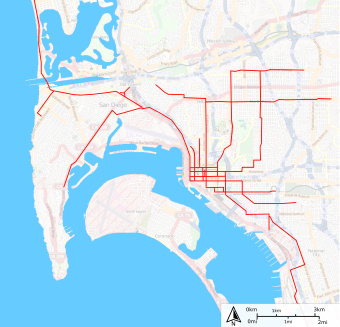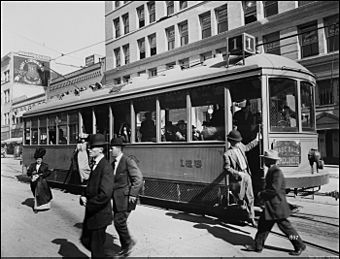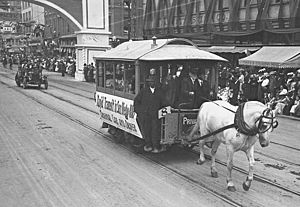San Diego Electric Railway facts for kids

San Diego Electric Railways network (interactive version)
|
|

A San Diego Class 1 streetcar at 5th and Broadway, around 1915
|
|
| Overview | |
|---|---|
| Headquarters | San Diego, California |
| Reporting mark | SDER |
| Locale | California |
| Dates of operation | 1892–1949 |
| Technical | |
| Track gauge | 4 ft 8 1⁄2 in (1,435 mm) standard gauge |
| Previous gauge | 3 ft 6 in (1,067 mm) (until about 1898) |
| Electrification | 600 V DC Overhead line |
The San Diego Electric Railway (SDERy) was a big public transportation system. It served Southern California, United States. This system used electric streetcars and later buses.
The SDERy started in 1892. A wealthy businessman named John D. Spreckels created it. The railway began with five main routes. These routes helped people travel around San Diego.
Over time, the company added more routes. This happened as more people needed rides. At its busiest, the SDERy had about 165 miles (266 km) of track. Its streetcars ran all over the greater San Diego area.
However, fewer people rode the streetcars over the years. This was because cars became very popular. So, the company stopped all streetcar service in 1949. They switched completely to buses instead.
Some old streetcars from the SDERy still exist today. You can see them at museums. These include the Pacific Southwest Railway Museum and the Southern California Railway Museum.
Contents
- History of San Diego's Streetcars
- Old Streetcar Routes
History of San Diego's Streetcars
Early Days: Horse-Drawn and Electric Cars
San Diego's first streetcar started running on July 3, 1886. It was pulled by horses and had an open top. The ride cost just five cents.
Soon after, electric streetcars arrived. On November 9, 1887, the first electric car had a test run. It went from Broadway to "Old Town."
Regular electric streetcar service began on November 19. This made San Diego one of the first cities on the West Coast with electric streetcars. Another company, the Electric Rapid Transit Company, also started electric service.
In 1889, the San Diego Cable Railway (SDCR) took over. They opened a fun park called "Mission Cliffs Gardens." This park was a special attraction at the end of their cable car line.
The San Diego Electric Railway Company Begins
John D. Spreckels officially started the San Diego Electric Railway Company (SDERy) in 1891. In 1892, the SDERy bought the first streetcar company. Over the next few years, they bought other railway lines too.
The company planned to make all lines electric. They bought new wooden streetcars. On September 21, 1892, a special double-decker car made its first trip. It was the first electric double-decker car in the United States.
By the end of 1892, the SDERy had grown a lot. They had about 16.7 miles (26.9 km) of track. Many new electric lines were built in the years that followed.
In 1895, a new company tried to compete with the SDERy. But they faced money problems. So, in 1898, the SDERy bought them out. The SDERy then made the tracks wider for their streetcars.
Growing the Network and Facing Challenges
In 1905, Spreckels built a new power plant. This was needed for the growing streetcar system. The next year, he announced plans for the San Diego and Arizona Railway. This was a long line connecting San Diego to El Centro.
The streetcar network kept expanding. By 1907, the Third Avenue Streetcar Line reached Mission Hills. Spreckels also got permission to operate his streetcar service for more than 25 years. This helped him get big loans to expand the system.
In 1911, a second power plant was built. The first one was not big enough anymore. The SDERy also ordered 24 new "Class 1" streetcars. These cars had a special Arts and Crafts design.
The Panama-California Exposition and World War I
The 1915 Panama–California Exposition in Balboa Park brought more growth. A new electric line was built to the park entrance. The company bought 101 new streetcars for the event.
In 1916, a "Great Flood" damaged several rail lines. Then, World War I made building materials much more expensive. Also, more people started buying cars. This meant the SDERy began to lose money.
In 1919, the San Diego and Arizona Railway was finished. It cost a lot of money to build. In 1920, Spreckels planned to close some rail lines. This was to save money. The SDERy also bought new streetcars that only needed one worker.
The Rise of Buses and Modern Streetcars
In 1921, the first motor bus started service. It ran between National City and Chula Vista. This bus had hard rubber tires and a plywood body.
In 1923, the SDERy made its last big rail line expansion. It went to Mission Beach, Pacific Beach, and La Jolla. They spent a lot of money on new tracks and stations. They also bought 50 new streetcars.
By 1930, buses began to replace streetcars on some routes. The company added 222 new buses to its fleet. Even though fewer people rode, the SDERy managed to survive the tough economic times.
In 1936, the SDERy ordered 25 modern PCC cars. These were sleek, streamlined streetcars. San Diego was one of the first cities to use these new cars.
World War II and the Final Switch
World War II made San Diego a very busy city. Many military people and defense workers moved there. Public transportation ridership went up by 600 percent. The SDERy bought used transit vehicles from other cities.
By 1942, streetcars and buses carried 94 million people. In 1944, they carried over 146 million trips. After the war, in 1946, the SDERy started replacing streetcar lines with bus routes. By 1947, only three streetcar lines were left.
New Owners and the End of Streetcars
On July 26, 1948, a new company bought the SDERy. It was called the Western Transit Company (WTC). The WTC quickly added new buses.
In September 1948, the WTC changed the company's name. It became the San Diego Transit System (SDTS). They also got a new slogan: "Safety, Courtesy, Service."
In January 1949, the SDTS decided to stop all streetcar service. The state approved their plan in March. A special "farewell" trip was held for the streetcars.
The next month, 45 new buses paraded down Broadway. This marked the end of streetcar service. San Diego became the first major city in the Southwest to switch to an all-bus system.
Many of the old PCC streetcars were sold. Some went to El Paso, Texas, to run between El Paso and Ciudad Juárez, Mexico. Other old cars were sold for scrap. However, some were saved for museums.
The San Diego Trolley: A New Beginning
After many years, a new electric rail system started in San Diego. It was called the "San Diego Trolley." Its first trip was on July 19, 1981. It ran between Downtown and the Mexican border.
San Diego became known as "The city that started the 'light rail craze' in the United States." This new system brought electric trains back to the city.
In 1996, three old "Class 1" streetcars were saved. These were cars that John Spreckels had ordered for the 1915 Panama California Exposition. They are now recognized as San Diego Landmark #339.
In 2005, the San Diego Vintage Trolley Co. bought some old PCC cars. One of them, Car No. 529, was fully fixed up. It now runs for the public.
The San Diego Metropolitan Transit System (MTS) also started a special "Silver Line" in 2011. This line uses the restored PCC streetcar #529. It runs around Downtown San Diego. MTS is also looking into extending this line to Balboa Park and the San Diego Zoo.
Old Streetcar Routes
Here are some of the main routes from 1925. This was when the system was at its biggest:
- 1 - From 5th Ave. to Hillcrest, then through University and Park Blvd. to Adams Ave.
- 2 - East on Broadway to South Park, then via 30th St. to North Park.
- 3 - Via Washington and Fort Stockton Ave. to Mission Hills.
- 4 - Imperial Ave. to 33rd and Commercial in Stockton.
- 5 - North from downtown on 1st Ave.; east from downtown on Market, south on 25th St., east on Ocean View Blvd. to 39th St. in Mountain View.
- 7 - Via Park Blvd. through Balboa Park to Hillcrest. Then east along University Ave. through North Park to City Heights.
- 9 - Served the marina at the end of Market St.
- 11 - Via 5th Ave. to Hillcrest, then via University and 30th to Adams Ave. It went along Adams to Normal Heights and Kensington.
- 12 - Connected Logan Heights, National City to Chula Vista.
- 13 - Kettner/Hancock to Rosecrans to La Playa in Point Loma.
- 14 - Served Ocean Beach.
- 15 - Used for holidays to Mission Beach Amusement Park.
- 16 - Connected Ocean Beach, Mission Beach, and La Jolla.




